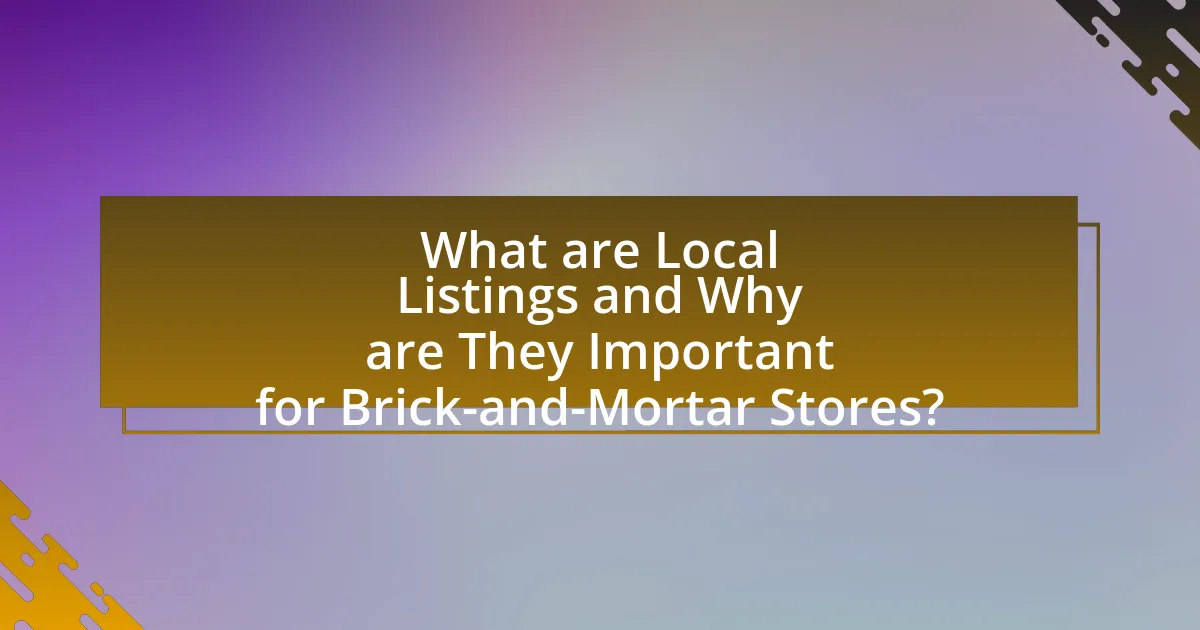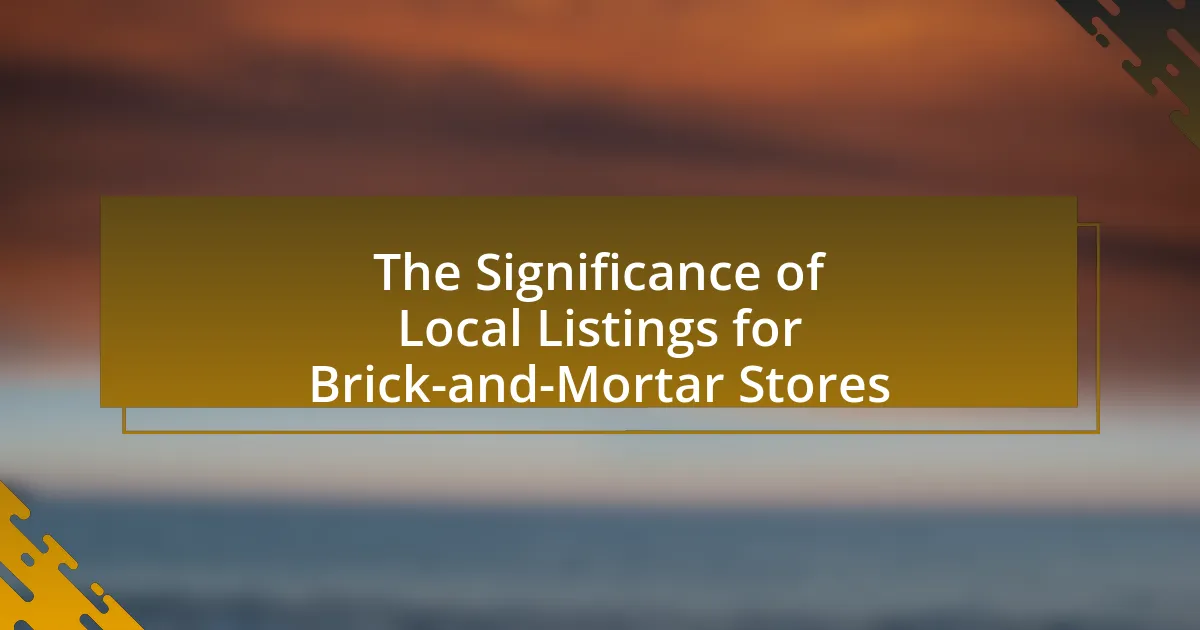Local listings are online profiles that provide essential information about brick-and-mortar stores, including their name, address, phone number, and operating hours. These listings are vital for enhancing visibility in local search results, driving foot traffic, and improving customer trust through reviews and ratings. The article explores the impact of local listings on customer visibility, the role of search engines, the types of listings available, and the differences between free and paid options. It also addresses the challenges stores face with local listings, the importance of maintaining accurate information, and best practices for optimizing these listings to attract and retain customers.

What are Local Listings and Why are They Important for Brick-and-Mortar Stores?
Local listings are online profiles that provide essential information about a brick-and-mortar store, including its name, address, phone number, and operating hours. These listings are crucial for brick-and-mortar stores because they enhance visibility in local search results, making it easier for potential customers to find and visit the physical location. According to a study by Google, 76% of people who search for something nearby visit a business within a day, highlighting the importance of accurate local listings in driving foot traffic. Additionally, local listings can improve a store’s credibility through customer reviews and ratings, further influencing purchasing decisions.
How do Local Listings impact customer visibility?
Local listings significantly enhance customer visibility by ensuring that businesses appear in relevant search results when potential customers look for products or services in their area. According to a study by Google, 76% of people who search for something nearby visit a business within a day, highlighting the importance of local listings in driving foot traffic. Furthermore, local listings improve search engine optimization (SEO) by providing accurate business information, which helps search engines rank the business higher in local search results. This increased visibility leads to higher engagement rates, as customers are more likely to click on businesses that appear prominently in local searches.
What role do search engines play in Local Listings?
Search engines play a crucial role in local listings by aggregating and displaying relevant business information to users based on their geographic location. This functionality enhances visibility for brick-and-mortar stores, as search engines utilize algorithms to prioritize local results, ensuring that users find nearby businesses that meet their search criteria. According to a study by Google, 76% of people who search for something nearby visit a business within a day, highlighting the effectiveness of search engines in driving foot traffic to local stores.
How do Local Listings enhance online presence for physical stores?
Local listings enhance the online presence of physical stores by improving visibility in local search results. When a store is listed on platforms like Google My Business, Yelp, or Bing Places, it becomes more accessible to potential customers searching for products or services in their vicinity. According to a study by Google, 76% of people who search for something nearby visit a business within a day, highlighting the importance of local listings in driving foot traffic. Additionally, local listings provide essential information such as address, phone number, and operating hours, which helps customers find and engage with the store easily. This increased visibility and accessibility ultimately lead to higher customer engagement and sales for brick-and-mortar stores.
What types of Local Listings exist for Brick-and-Mortar Stores?
Local listings for brick-and-mortar stores primarily include Google My Business, Yelp, Bing Places, Facebook Business Pages, and Apple Maps. These platforms allow businesses to provide essential information such as location, hours of operation, and customer reviews. For instance, Google My Business is widely recognized, with over 90% of consumers using it to find local businesses, highlighting its importance in local search visibility. Each listing type enhances a store’s online presence, making it easier for potential customers to discover and engage with the business.
What are the differences between free and paid Local Listings?
Free local listings provide basic information about a business, such as name, address, and phone number, while paid local listings offer enhanced features like additional images, promotional content, and higher visibility in search results. Free listings typically appear lower in search rankings and may have limited customization options, whereas paid listings can improve a business’s online presence and attract more customers through targeted advertising. According to a study by BrightLocal, businesses that invest in paid listings see a 30% increase in customer engagement compared to those relying solely on free listings.
How do social media platforms contribute to Local Listings?
Social media platforms enhance local listings by providing businesses with a space to share their location, hours, and services, which improves visibility in local search results. For instance, platforms like Facebook and Instagram allow businesses to create profiles that include essential information, which can be indexed by search engines. According to a study by BrightLocal, 46% of consumers use social media to find local businesses, demonstrating the direct impact of social media on local listing visibility. Additionally, user-generated content and reviews on these platforms can influence local SEO rankings, further solidifying the connection between social media engagement and local listings.
Why should Brick-and-Mortar Stores prioritize Local Listings?
Brick-and-mortar stores should prioritize local listings because they significantly enhance visibility and attract nearby customers. Local listings improve search engine optimization (SEO), making it easier for potential customers to find stores in their vicinity. According to a study by Google, 76% of people who search for something nearby visit a business within a day, highlighting the importance of being listed accurately in local directories. Furthermore, consistent and optimized local listings can lead to higher foot traffic and increased sales, as they provide essential information such as location, hours, and customer reviews, which influence purchasing decisions.
What are the potential consequences of neglecting Local Listings?
Neglecting local listings can lead to decreased visibility and reduced foot traffic for brick-and-mortar stores. When businesses fail to maintain accurate and up-to-date local listings, potential customers may struggle to find essential information such as location, hours of operation, and contact details. According to a study by BrightLocal, 46% of consumers reported that inaccurate information on local listings led them to lose trust in a business. Additionally, poor local listing management can negatively impact search engine rankings, as search engines prioritize accurate and consistent information. This can result in lower online visibility, ultimately affecting sales and customer engagement.
How do Local Listings influence consumer trust and decision-making?
Local listings significantly influence consumer trust and decision-making by providing essential information about businesses, such as location, hours, and customer reviews. These listings enhance visibility in search results, making it easier for consumers to find and evaluate options. According to a survey by BrightLocal, 84% of consumers trust online reviews as much as personal recommendations, indicating that positive reviews in local listings can directly impact purchasing decisions. Furthermore, accurate and up-to-date information in local listings fosters trust, as consumers are more likely to engage with businesses that present themselves reliably.
How can Brick-and-Mortar Stores optimize their Local Listings?
Brick-and-mortar stores can optimize their local listings by ensuring accurate and consistent information across all online platforms. This includes verifying that the business name, address, phone number, and operating hours are correct on Google My Business, Yelp, and other relevant directories. Consistency in these details helps improve search engine rankings and enhances visibility to local customers. Additionally, encouraging customer reviews and responding to them can boost credibility and engagement, as studies show that businesses with positive reviews attract more customers. Implementing local keywords in business descriptions and posts can also enhance search relevance, making it easier for potential customers to find the store online.
What key information should be included in a Local Listing?
A Local Listing should include the business name, address, phone number, website, hours of operation, and categories of services offered. This information is crucial for ensuring that potential customers can easily find and contact the business. Accurate details help improve local search visibility, as studies show that 76% of people who search for something nearby visit a business within a day. Additionally, including customer reviews and photos can enhance credibility and attract more visitors.
How often should Brick-and-Mortar Stores update their Local Listings?
Brick-and-Mortar Stores should update their Local Listings at least once a month. Regular updates ensure that information such as hours of operation, contact details, and services offered remain accurate, which is crucial for maintaining visibility in local search results. According to a study by BrightLocal, 56% of consumers reported that they have encountered incorrect information about a local business, which can lead to lost customers. Therefore, consistent updates help mitigate inaccuracies and enhance customer trust.

What are the Benefits of Local Listings for Brick-and-Mortar Stores?
Local listings provide significant benefits for brick-and-mortar stores by enhancing visibility and driving foot traffic. These listings ensure that businesses appear in local search results, making it easier for potential customers to find them. According to a study by Google, 76% of people who search for something nearby visit a business within a day, highlighting the importance of local visibility. Additionally, local listings often include essential information such as hours of operation, address, and customer reviews, which can influence purchasing decisions. This accessibility and credibility foster trust among consumers, ultimately leading to increased sales and customer loyalty.
How do Local Listings drive foot traffic to physical locations?
Local listings drive foot traffic to physical locations by enhancing visibility and accessibility for consumers searching for nearby businesses. When businesses are listed on platforms like Google My Business, Yelp, or Bing Places, they appear in local search results, maps, and relevant directories, making it easier for potential customers to find them. According to a study by Google, 76% of people who search for something nearby visit a business within a day, highlighting the direct correlation between local listings and increased foot traffic. Additionally, local listings often include essential information such as hours of operation, contact details, and customer reviews, which further influence consumer decisions to visit a physical location.
What statistics support the effectiveness of Local Listings in attracting customers?
Local listings significantly enhance customer attraction, with 76% of consumers visiting a business within a day of searching for it online. Additionally, 88% of consumers trust online reviews as much as personal recommendations, indicating that local listings with positive reviews can drive foot traffic. Furthermore, businesses with complete local listings receive 7 times more clicks than those with incomplete information, demonstrating the importance of accurate and comprehensive listings in capturing customer interest.
How do Local Listings enhance local SEO for Brick-and-Mortar Stores?
Local listings enhance local SEO for brick-and-mortar stores by improving visibility in local search results. When a store is listed on platforms like Google My Business, Yelp, and Bing Places, it provides essential information such as location, hours, and services, which helps search engines understand the business’s relevance to local queries. According to a study by Moz, local listings account for 25% of local pack ranking factors, indicating their significant role in search engine optimization. Additionally, accurate and consistent local listings can lead to higher click-through rates and increased foot traffic, as 76% of people who search for something nearby visit a business within a day.
What competitive advantages do Local Listings provide?
Local listings provide competitive advantages by enhancing visibility and driving foot traffic to brick-and-mortar stores. They improve search engine rankings, as businesses with optimized local listings appear higher in local search results, making them more accessible to potential customers. According to a study by Google, 76% of people who search for something nearby visit a business within a day, demonstrating the effectiveness of local listings in converting online searches into in-store visits. Additionally, local listings allow businesses to showcase essential information such as hours of operation, location, and customer reviews, which can influence purchasing decisions and build trust with consumers.
How can Local Listings help differentiate a store from its competitors?
Local listings can help differentiate a store from its competitors by enhancing visibility and providing essential information that attracts potential customers. When a store is accurately listed on platforms like Google My Business, it appears in local search results, making it easier for customers to find it compared to competitors who may not be listed or have incomplete information. According to a study by BrightLocal, 46% of all Google searches are seeking local information, indicating that a well-optimized local listing can significantly increase foot traffic and customer engagement. Additionally, local listings often include customer reviews, photos, and business details, which can influence consumer decisions and create a competitive edge.
What role do customer reviews in Local Listings play in building reputation?
Customer reviews in Local Listings play a crucial role in building reputation by influencing potential customers’ perceptions and decisions. Positive reviews enhance credibility and trust, leading to increased foot traffic and sales for brick-and-mortar stores. According to a study by BrightLocal, 87% of consumers read online reviews for local businesses, and 79% trust online reviews as much as personal recommendations. This demonstrates that customer feedback directly impacts a store’s reputation and can significantly affect its success in a competitive market.

What Challenges do Brick-and-Mortar Stores Face with Local Listings?
Brick-and-mortar stores face several challenges with local listings, primarily including inaccurate information, competition from online retailers, and managing customer reviews. Inaccurate information, such as incorrect addresses or business hours, can lead to customer frustration and lost sales; a study by Google indicates that 28% of consumers will lose trust in a business if they find incorrect information online. Additionally, brick-and-mortar stores often compete with online retailers that dominate local search results, making it difficult for them to attract foot traffic. Finally, managing customer reviews is crucial, as negative reviews can significantly impact a store’s reputation; according to a survey by BrightLocal, 87% of consumers read online reviews for local businesses, highlighting the importance of maintaining a positive online presence.
What common mistakes do stores make with their Local Listings?
Stores commonly make mistakes with their Local Listings by providing inconsistent or inaccurate information. This includes errors in business name, address, phone number, and operating hours, which can lead to customer confusion and lost sales opportunities. According to a survey by BrightLocal, 80% of consumers lose trust in local businesses if their listings have incorrect information. Additionally, failing to claim or verify listings on platforms like Google My Business can result in missed visibility in local search results. Lastly, neglecting to update listings with new services, promotions, or changes in hours can diminish customer engagement and satisfaction.
How can inaccurate information in Local Listings harm a business?
Inaccurate information in local listings can significantly harm a business by leading to lost customers and diminished trust. When potential customers encounter incorrect details such as wrong addresses, phone numbers, or operating hours, they may become frustrated and choose competitors instead. A study by BrightLocal found that 73% of consumers lose trust in a brand if they see inaccurate information online. This loss of trust can result in decreased foot traffic and sales, ultimately affecting the business’s bottom line.
What are the implications of negative reviews in Local Listings?
Negative reviews in local listings significantly impact consumer perception and business performance. They can lead to decreased foot traffic, as potential customers often rely on reviews to make informed decisions; studies show that 84% of people trust online reviews as much as personal recommendations. Additionally, negative reviews can lower a business’s search engine ranking, making it less visible to potential customers. This visibility issue is critical, as 78% of local mobile searches result in an offline purchase. Furthermore, businesses with a high volume of negative reviews may struggle to build a positive brand reputation, which can deter new customers and lead to long-term financial consequences.
How can Brick-and-Mortar Stores overcome these challenges?
Brick-and-mortar stores can overcome challenges by optimizing their local listings to enhance visibility and attract customers. By ensuring accurate and consistent information across platforms like Google My Business, Yelp, and social media, these stores can improve their search rankings and drive foot traffic. Research indicates that 76% of consumers who search for something nearby visit a business within a day, highlighting the importance of local SEO. Additionally, engaging with customer reviews and utilizing local keywords can further strengthen their online presence, making it easier for potential customers to find them.
What strategies can be implemented to maintain accurate Local Listings?
To maintain accurate Local Listings, businesses should regularly verify and update their information across all platforms. This includes ensuring that the name, address, phone number, and operating hours are consistent and correct on Google My Business, Yelp, and other relevant directories. Regular audits of listings can help identify discrepancies, and utilizing tools like Moz Local or Yext can streamline the management process. According to a 2021 survey by BrightLocal, 87% of consumers read online reviews for local businesses, highlighting the importance of accurate listings for customer trust and engagement.
How can stores effectively manage customer feedback in Local Listings?
Stores can effectively manage customer feedback in Local Listings by actively monitoring reviews, responding promptly, and utilizing feedback for improvements. Active monitoring involves regularly checking platforms like Google My Business and Yelp to stay updated on customer sentiments. Prompt responses to both positive and negative reviews demonstrate engagement and commitment to customer satisfaction, which can enhance the store’s reputation. Additionally, analyzing feedback trends allows stores to identify areas for improvement, leading to better service and customer experiences. Research indicates that businesses that respond to reviews can increase customer trust by up to 70%, highlighting the importance of managing feedback effectively.
What are the best practices for maintaining Local Listings?
The best practices for maintaining local listings include ensuring consistent and accurate business information across all platforms, regularly updating listings with current details, and actively managing customer reviews. Consistency in business name, address, and phone number (NAP) is crucial, as discrepancies can confuse customers and negatively impact search rankings. Regular updates, such as changes in hours or services, keep listings relevant and trustworthy. Actively responding to customer reviews, both positive and negative, enhances engagement and builds a positive online reputation, which is essential for attracting local customers.
How can Brick-and-Mortar Stores ensure consistency across multiple platforms?
Brick-and-mortar stores can ensure consistency across multiple platforms by implementing a centralized data management system that synchronizes information such as store hours, addresses, and contact details across all listings. This approach minimizes discrepancies and enhances customer trust. For instance, a study by BrightLocal in 2022 found that 64% of consumers expect to find consistent information across online platforms, highlighting the importance of accuracy in local listings. By regularly auditing and updating their information on platforms like Google My Business, Yelp, and social media, brick-and-mortar stores can maintain uniformity and improve their visibility in local searches.
What tools are available to help manage Local Listings effectively?
Tools available to help manage Local Listings effectively include Google My Business, Moz Local, Yext, and BrightLocal. Google My Business allows businesses to create and manage their online presence across Google, including Search and Maps, which is crucial for local visibility. Moz Local helps ensure accurate business listings across various directories, improving local SEO. Yext offers a comprehensive platform for managing listings, reviews, and location data across multiple sites, enhancing brand consistency. BrightLocal provides tools for citation tracking, reputation management, and local SEO audits, enabling businesses to optimize their local presence. These tools collectively enhance visibility, accuracy, and engagement in local search results, which is vital for brick-and-mortar stores.
